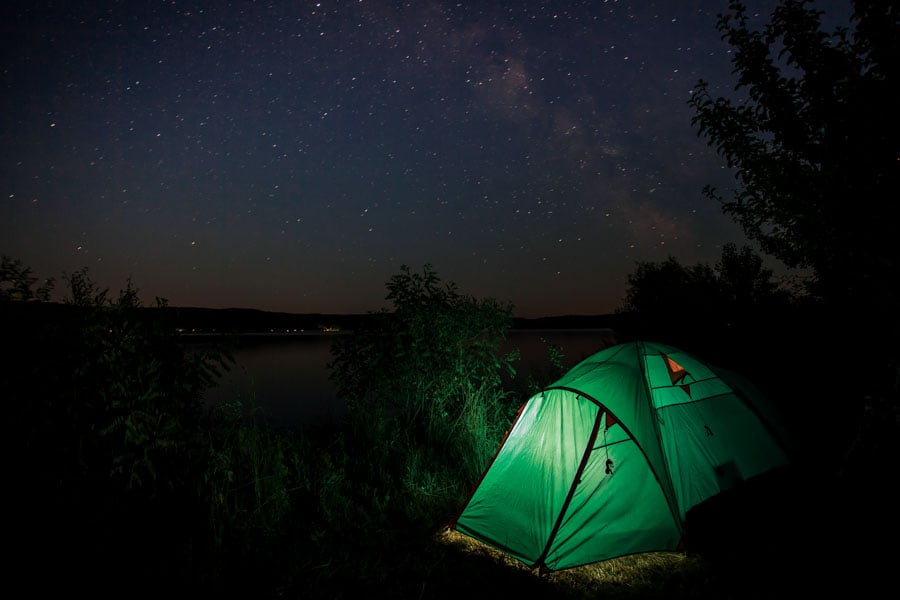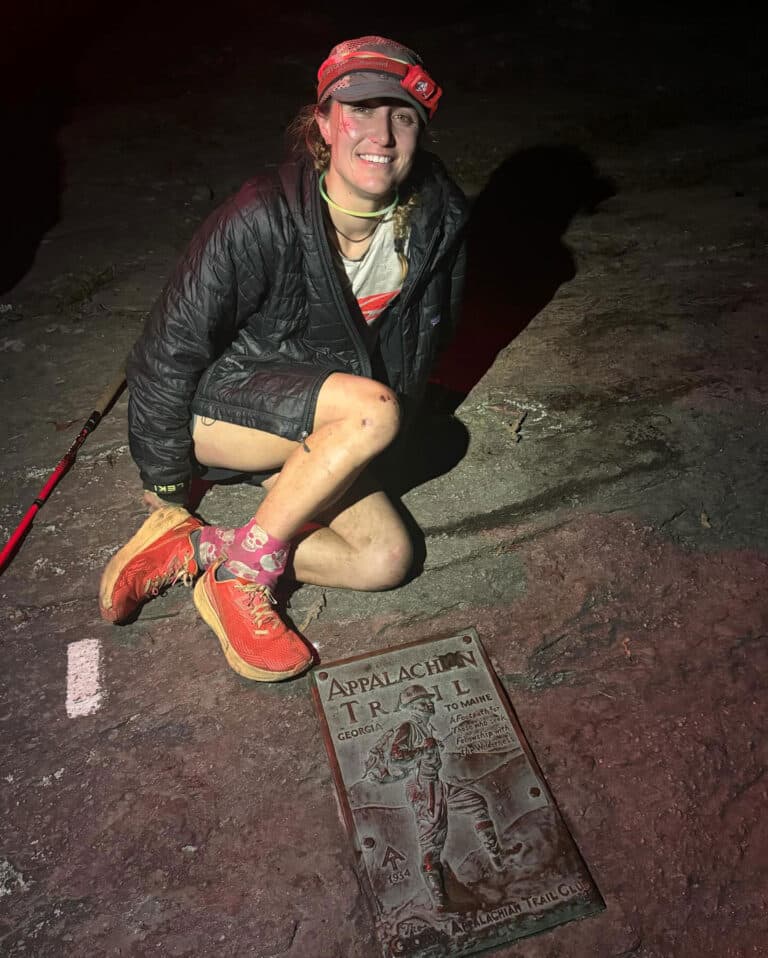High beams blinding you from your rear-view mirror. A sea of streetlamps on every parking lot and roadway. Neon lights pierce through the dark, advertising everything from beer to ice cream to auto parts.
Sometimes, you just want to get away from it all.
As the landscape glows ever brighter, it gets harder and harder to find quiet refuges away from artificial illumination. Overabundant outdoor lighting obscures the night sky, making it impossible to see any but the brightest of stars. The nighttime canvas freckled with a million pinpricks of light gets reduced to a boring backdrop when seen from an urban vantage point. East of the Mississippi River in particular, dark areas are rapidly vanishing due to the country’s disproportionate population distribution and increasing urban sprawl.
Usually when we want to draw attention to something, we shine a light on it, but when it comes to the night sky, the literal stars of the show are already plenty bright. It’s only by darkening our vantage point that we can see the heavens in their full glory
Fortunately, concerned public land managers and engaged citizens have begun advocating for unobstructed night skies and preserving landscapes, known as dark-sky places, where curious visitors can still see the heavens as nature intended. Additionally, these sanctuaries offer havens for wildlife, particularly nocturnal animals whose biological rhythms rely on the daily transition of day to night, and migratory species that depend on the moon and stars to guide their passage.
In Appalachia, four parks have been recognized as dark-sky places by the International Dark-Sky Association (IDA). At these areas, professional astronomers and amateur stargazers alike can cast their eyes and telescopes to the skies for a much more spectacular array than they can find at home.
Cherry Springs State Park Coudersport, Pennsylvania
“It’s funny,” says Angela Anderson, a former NASA employee who grew up a few miles from Cherry Springs State Park. “I was always fascinated with the night sky and didn’t realize how much of a luxury it was to live in such a remote place.”
Indeed, even the nearest medium-sized city of Harrisburg is more than 100 miles away. In 2000, Pennsylvania declared Cherry Springs the first dark-sky park in the Commonwealth, and in 2008, IDA awarded it top Gold-Tier status and designated it as the second international dark-sky park in the world.
Anderson’s colleagues at NASA in Cleveland would make the 250-mile drive to Cherry Springs for its unparalleled nightscapes. Last summer, she introduced her husband to the park’s dazzling skies. “We had a great time taking pictures and seeing the Milky Way with just our naked eyes,” she says. “The long exposure photos came out even better.”
The park also offers dome observatories, available to rent for $25 per night. The Cherry Springs Star Party occurs each June, followed by the Black Forest Star Party each September.
Pickett-Pogue State Park And Natural Area, Jamestown, Tennessee
Pickett State Park and Pogue Creek Canyon State Natural Area in Tennessee received their Silver-Tier IDA certification in 2015. Public land managers for the joint property recognized their area’s rare dark skies a few years back and began working to reduce light pollution in and around the park.
“We first did several measurements throughout the park to determine the amount of artificial light in the night sky,” says Park Ranger Monique Hodge. Staff assessed each park light fixture for IDA compliance, and they are now replacing dozens of installations. By this summer, they expect to have replaced all of their non-compliant fixtures to improve sky quality for visitors.
With the help of Nashville’s Barnard-Seyfert Astronomical Society and Paul Lewis, director of the University of Tennessee-Knoxville’s Space Science Outreach program, Pickett-Pogue has developed dark-sky programs to engage and educate the public year-round. Even nearby towns are committing to install dark sky-friendly lighting.
“There are few remaining dark sky areas left in Tennessee, and we are one of those few areas,” says Hodge. “It’s important to preserve the night sky for future generations.”
Blue Ridge Star Park and Observatory, Spruce Pine, North Carolina
Twice last year, the Blue Ridge Star Park hosted a group of visually impaired people to give them an unusual opportunity to observe night-sky phenomena. Most of these visitors were not totally blind, and the absence of light pollution in this part of the North Carolina mountains allowed many of them to view brighter celestial objects, like the double star Albireo. A person with good vision may not be able to see this pairing from within a brightly lit city, but the ideal conditions offered by this park allow even people with poor vision to see distinct objects in the night sky.
Mayland Community College, which has managed the Yancey County-owned site since 2013, worked with the Blue Ridge Astronomy Group to develop a dark-sky compliance plan, ultimately achieving Silver-Tier certification for the park in 2014. Last fall, the different stakeholders broke ground on a new observatory. When finished, it will feature a 34-inch Newtonian telescope, which will be the largest in the Southeast dedicated for public use.
Staunton River State Park, Scottsburg, Virginia
Every year, for a week, a group of about 200 people quietly watch the sky into the wee hours of the morning beside the Staunton River. Small red lights glow here and there across the wide field.
“Red light helps so you don’t lose your dark adaptation,” explains Gabe, a thoughtful 13-year-old observer and member of CHAOS, the Chapel Hill Astronomical and Observational Society, which organizes the biannual event with the park.
An astronomy buff since preschool, Gabe has learned to appreciate the rare conditions this park offers. “It’s great that one of the few dark-sky places on the East Coast is accessible from so many places, and that the park recognizes what they have and tries to make a point of preserving the dark skies here.”
Park Manager Adam Layman credits the park’s 2015 IDA designation as a Silver-Tier park to CHAOS and specifically CHAOS President Jayme Hanzak. When Hanzak pored over a light pollution map a few years ago and realized a state park sat in a dark area less than two hours from Chapel Hill, he reached out to Layman to start talking about how they could collaborate.
The club held the park’s first Star Party in 2011, and they worked with park staff to meet IDA requirements for dark-sky certification. Staunton River now serves as the model the state park system plans to use to implement dark-sky-friendly lighting in all of their parks. Throughout the year, CHAOS and the park co-host astronomy programs, and visitors can borrow telescopes donated by the club for independent observing.
At last fall’s Staunton River Star Party, Hanzak recalled his first spark of interest in the night sky, which came during his childhood on an early-morning paper route. Cloaked in darkness but dazzled by stars, he remembers thinking, “Wow, we are pretty little,” he says. “Now, coming out here helps keep things in perspective.”







